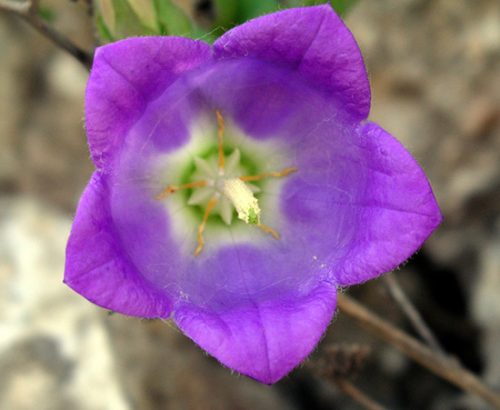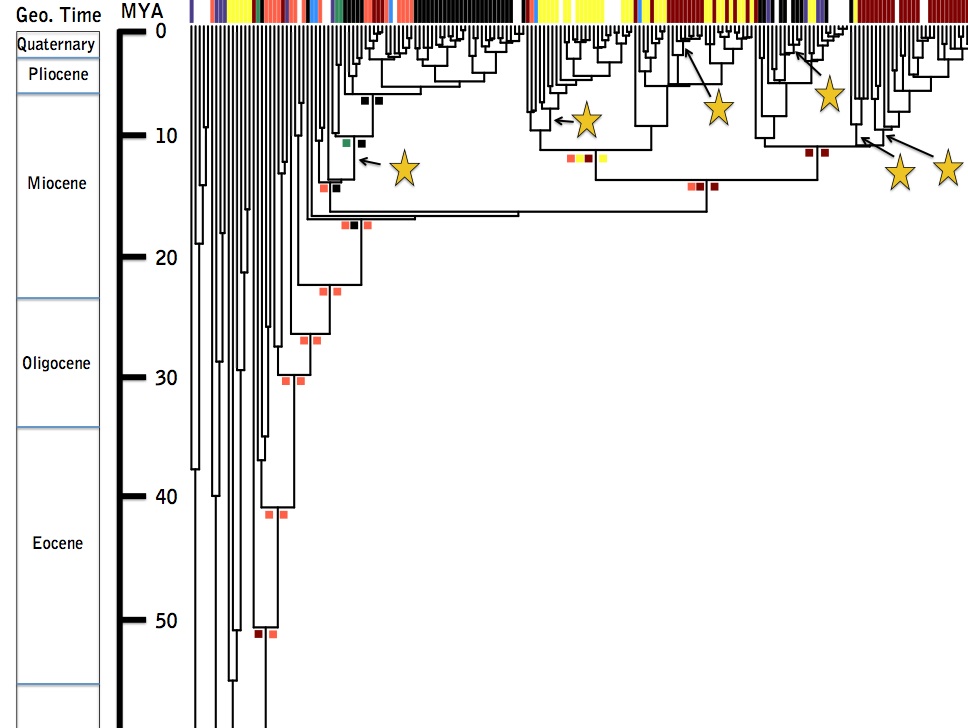Campanulaceae are a large, cosmopolitan angiosperm clade with diverse pollinator adaptations including specialized floral morphologies and secondary pollen presentation mechanisms. We are investigating the the broad-scale relationships of this ca. 65 million year old clade. Along with the relationships of the five major lineages, we are interested in early dispersal events, floral changes, diversification, genome duplications, and chromosome evolution within this large clade. Additionally, we focus on specific subclades, intercontinental disjunctions, and/or biomes to disentangle the complex evolution of many taxa, for example Campanula in the Mediterranean, Lobelia in North America, Triodanis and Legousia, among others. Understanding the evolutionary history of these groups provides insights into past and current forces that are driving diversification and biogeographic patterns in many regions of the world.
NSF DEB-2348709 COLLABORATIVE RESEARCH: Diversification, Disjunction, and Decline in the Mediterranean Basin: Insights from Endemic Bellflowers (Campanulaceae)
NSF DEB-2015594 COLLABORATIVE RESEARCH: BEE: Ecological and evolutionary processes affecting the co-existence of close relatives
NSF DEB-1501676 DISSERTATION RESEARCH: Integrating Biogeography, Cytology, Niche Modeling and Phylogenetics to Understand the Evolutionary History of Endemic Campanula Species in the Mediterranean
NSF DEB-0953677 CAREER: Evolution in the Eastern Mediterranean Campanulaceae – Integrating Information Management and Scientific Workflows in Daily Research and Teaching
Simmonds, T., Geralds, B.N., Cellinese, N., Crowl, A.A., Brown, J.L., Weber, J. 2024.Paleo-climates and past introgression explain the spatio-temporal distribution of genetic structure in Triodanis perfoliata. Frontiers of Biogeography, doi.org/10.21425/F5FBG61656.
Liveri, E.*, Crowl, A.A., Mavrodiev, E., Yıldırım, H., Kamari, G., Cellinese, N. 2020. Another piece of the puzzle, another brick in the wall: the inevitable fate of Campanula section Quinqueloculares (Campanulaceae: Campanuloideae). TAXON. https://doi.org/10.1002/tax.12372 *Visiting scholar.
Cellinese, N. Campanulaceae. 2020. In Phylonyms: a Companion to the PhyloCode (K. de Queiroz, P.D. Cantino & J. Gauthier, eds), pp. 381-384. CRC Press.
Cellinese, N. Campanuloideae. 2020. In Phylonyms: a Companion to the PhyloCode (K. de Queiroz, P.D. Cantino & J. Gauthier, eds), pp. 385-386. CRC Press.
Cellinese, N. Lobelioideae. 2020. In Phylonyms: a Companion to the PhyloCode (K. de Queiroz, P.D. Cantino & J. Gauthier, eds), pp. 386-387. CRC Press.
Liveri, E.*, Crowl, A.A., Cellinese, N. 2019. Past, present, and future of Campanula (Campanulaceae) systematics. Botanika Chronica 22: 209-222. *Visiting scholar.
Yoo, K.-O.*, Crowl, A.A., Kim, K-A, Cheon, K-S, Cellinese, N. 2018. Origins of East Asian Campanuloideae (Campanulaceae) diversity. Molecular Phylogenetics and Evolution 127: 468-474. *Visiting scholar.
Crowl, A., Myers, C., Cellinese, N. 2017. Embracing discordance: phylogenetic analyses provide evidence for allopolyploidy leading to cryptic diversity in a Mediterranean Campanula (Campanulaceae) clade. Evolution
Crowl, A., Cellinese, N. 2017. Naming diversity in an evolutionary context: Phylogenetic definitions of the Roucela clade (Campanulaceae/Campanuloideae) and the cryptic taxa within. Ecology and Evolution 10.1002/ece3.3442
Crowl, A., Miles, N., Visger, C., Hansen, K., Ayers, T., Haberle, R., Cellinese, N. 2016. A global perspective on Campanulaceae: biogeographic, genomic, and floral evolution. American Journal of Botany 103: 233-245.
Crowl, A., Visger, C., Mansion, G., Hand, R., Wu, H.-H., Kamari, G., Phitos, D., Cellinese, N. 2015. Evolution and Biogeography of the Endemic Roucela complex (Campanulaceae: Campanula) in the Eastern Mediterranean. Ecology & Evolution 10.1002/ece3.1791
Crowl, A.A., Mavrodiev, E., Mansion, G., Haberle, R., Pistarino, A., Kamari, G., Phitos, D., Borsch, T., Cellinese, N. 2014. Phylogeny of Campanuloideae (Campanulaceae) with emphasis on the utility of pentatricopeptide repeat (PPR) genes. PLoS One 9: e94199.
Fenaroli, F., Pistarino, A., Peruzzi, L., Cellinese, N. 2013. Campanula martinii (Campanulaceae), a new species from northern Italy. Phytotaxa 111(1): 27-38.
Mansion, G., Parolly, G., Crowl, A., Mavrodiev, E., Cellinese, N., Oganesian, M., Fraunhofer, K., Kamari, K., Phitos, D., Haberle, R., Akaydin, G., Ikinci, N., Raus, T., Borsch, T. 2012. How to Handle Speciose Clades? Mass Taxon-Sampling as a Strategy towards Illuminating the Natural History of Campanula (Campanuloideae). PLoS One 7(11): e50076.
Cellinese, N., S.A. Smith, E.J. Edwards, S.-T. Kim, R.C. Haberle, M. Avramakis, M.J. Donoghue. 2009. Historical Biogeography of the endemic Campanulaceae of Crete. Journal of Biogeography 36:1253-1269.
Haberle, R.C., A. Dang, T. Lee, C. Penaflor, H. Cortes-Burn, A. Oestreich, L. Raubenson, N. Cellinese, E.J. Edwards, S.-T. Kim, W.M.M. Eddie, R.K. Jansen. 2009. Taxonomic and biogeographic implications of a phylogenetic analysis of the Campanulaceae based on three chloroplast genes. Taxon 58:715-734.

